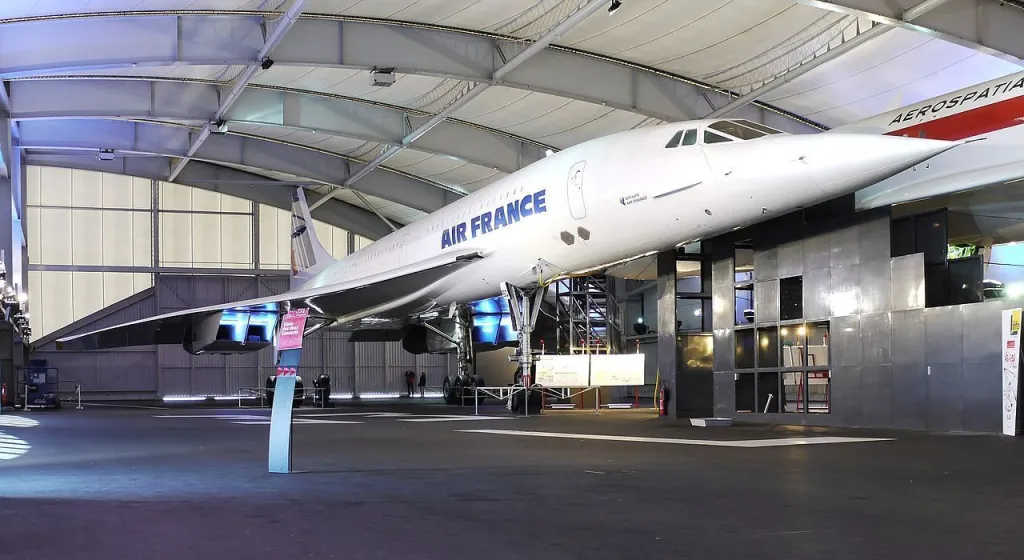The National Air and Space Museum of France, known as the Musée de l’Air et de l’Espace, offers a fascinating journey through the development of aviation and space exploration, from the earliest days of flight to the conquest of space. Located just 10 minutes by car from central Paris, the museum occupies part of Le Bourget Airport, the first major airport to serve the French capital.
With an extensive collection, the museum is a true paradise for aviation and space enthusiasts. Among its impressive exhibits, a standout feature is an Airbus A380, over 70 meters long, parked just meters away from a Boeing 747, an iconic aircraft that once held the title of “Queen of the Skies.” Visitors can also admire two supersonic Concorde jets displayed side by side, while nearby galleries showcasing World War II planes reflect past technological innovations.

The Musée de l’Air et de l’Espace houses more than 350 aircraft, satellites, rockets, artworks, uniforms, and historical documents. Its exhibits span three major areas of aviation: ballooning, aviation, and space exploration. In addition to aircraft and spacecraft, the museum offers a rich collection of historical items, providing a comprehensive view of the evolution of flight technology and achievements in space.
The National Air and Space Museum of France is a vast and diverse space, offering visitors a complete experience with its nine distinct exhibition halls, an outdoor area near the runway, a planetarium, and an interactive children’s area with educational activities about aeronautics and space.
One of the museum’s main attractions is the gallery dedicated to aviation pioneers. This section takes visitors on a journey through time, from early balloon experiments to the dawn of modern aviation. A highlight is the Demoiselle airplane, designed by Alberto Santos Dumont. Completed in 1908, the Demoiselle is notable for its innovative structure, featuring a bamboo fuselage and a design aimed at mass production.
Another must-see is the Concorde Hall, where the iconic Concorde jets are displayed. This space is unique in the world, offering visitors the chance to see two of these extraordinary supersonic planes, a British-French collaboration that could reach nearly twice the speed of sound. In the post-war era, the Concorde marked a significant advance in commercial aviation and remains a symbol of innovation and speed.
Beyond its indoor exhibits, the museum features an outdoor area where visitors can view various aircraft and rockets close to Le Bourget Airport’s runway. The planetarium provides an immersive experience into the wonders of the cosmos, while the children’s area offers a fun, interactive approach to learning about aeronautics and space exploration.
In the outdoor area of the National Air and Space Museum, visitors have the opportunity to get up close to some of the greatest marvels of aviation and space exploration. Highlights include an Airbus A380, the largest commercial plane in the world, and a Boeing 747. Also on display are two full-scale models of Ariane I and Ariane V rockets, measuring an impressive 47 and 50 meters, respectively. These rockets, built by the European Space Agency (ESA), French National Centre for Space Studies (CNES), and Arianespace, are significant milestones in the history of space launches.
The museum also features galleries dedicated to French military aviation, showcasing autogyros, military helicopters, and historical artifacts that detail the development of military aviation from its beginnings in 1914 to World War II. These exhibits provide an in-depth look at innovations and achievements in the field of military aviation.
For children, the museum offers parallel activities that make the visit both fun and educational. In addition to exploring the planetarium, where they can learn about space and discover curiosities such as the Sun’s circumference and the time required to travel to Mars, children can enjoy the Planète Pilote area. This 1,000-square-meter space features over 40 interactive activities covering aeronautics and space exploration in an engaging and playful manner.
The National Air and Space Museum of France hosts a series of special events throughout the year, including outdoor film screenings projected onto the fuselage of a Boeing 747. These events provide a unique experience and are a great opportunity to enjoy the museum’s atmosphere in a different setting. To stay updated on special events and activities, it’s recommended to check the museum’s website.
The admission fee for the museum’s permanent exhibition is €17 for visitors over 26 years old. Entry is free for individuals under 26 and also on the first Sunday of every month. Certain additional activities within the museum, such as visiting specific aircraft, may have an extra cost ranging from €6 to €8.
The Musée de l’Air et de l’Espace is preparing for significant expansion in the coming years, with the arrival of the Grand Paris Express metro line 17, scheduled for 2026. Future additions include a new 4,000-square-meter building and a gallery dedicated to air traffic control, further enhancing the museum’s already impressive displays and facilities.
Musée de l’Air et de l’Espace Information:
- Location: Paris-Le Bourget Airport
- Opening Days: Open daily, except Mondays
- Hours:
- From April 1 to September 30: 10:00 AM to 6:00 PM
- From October 1 to March 31: 10:00 AM to 5:00 PM
These enhancements promise to transform the museum into an even more unmissable destination for aviation and space enthusiasts, offering a deep immersion into humanity’s achievements in these fascinating fields.
With these expansions, the Musée de l’Air et de l’Espace will not only increase its physical space but also its ability to educate and inspire future generations. The new air traffic control gallery, in particular, will provide a detailed and interactive look into airspace management, a crucial component of modern aviation.
Furthermore, the new building will offer more room for exhibits and activities, solidifying the museum’s status as a center of excellence for the history and innovation of aviation and space exploration. Thus, the Musée de l’Air et de l’Espace reaffirms its position as an essential destination for anyone looking to explore and understand the advancements in aerial and space technology.

